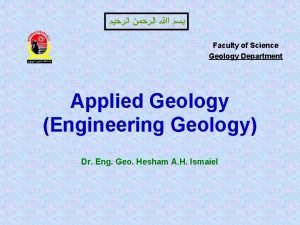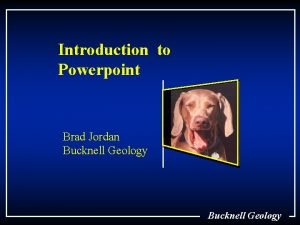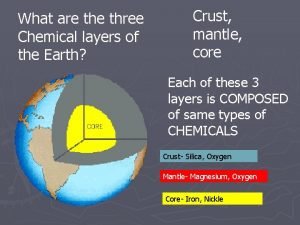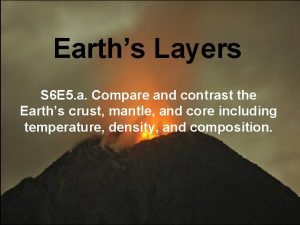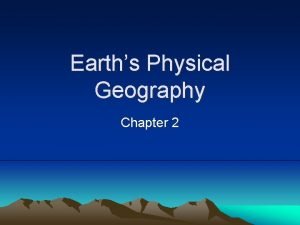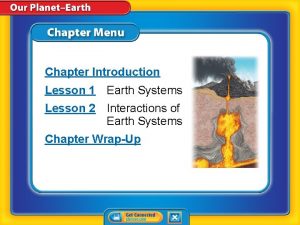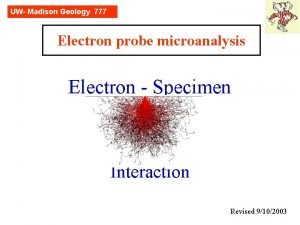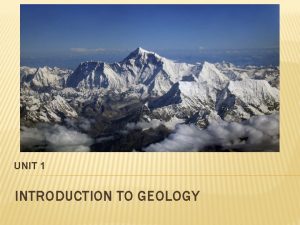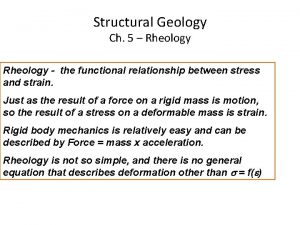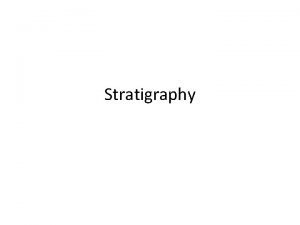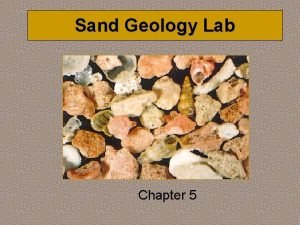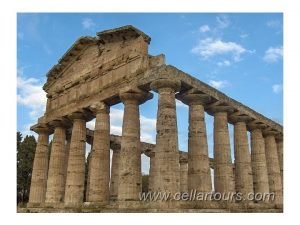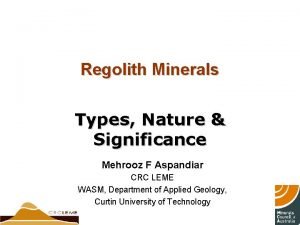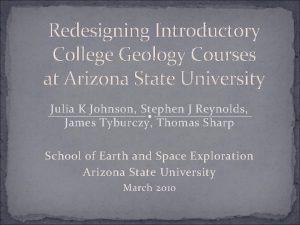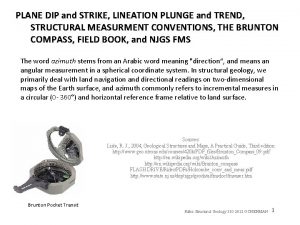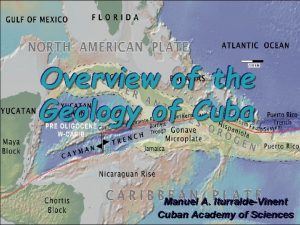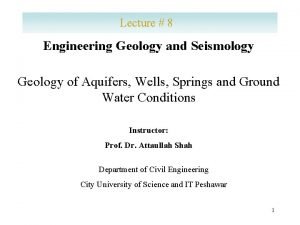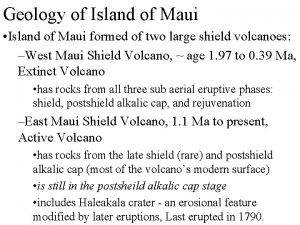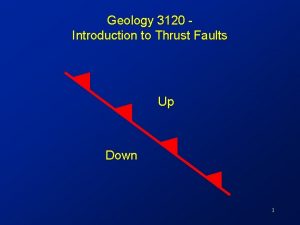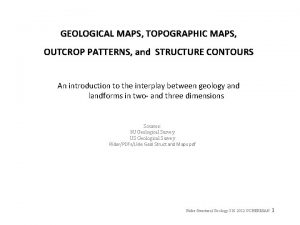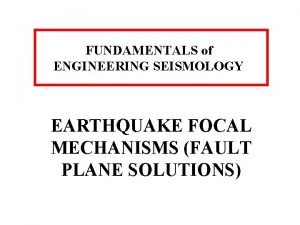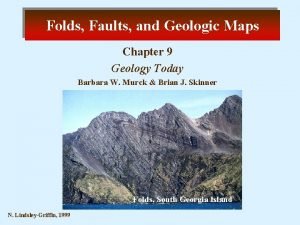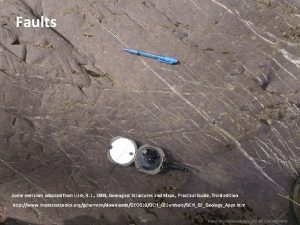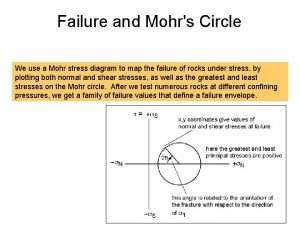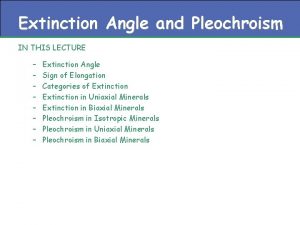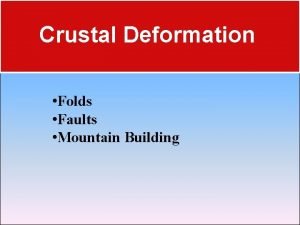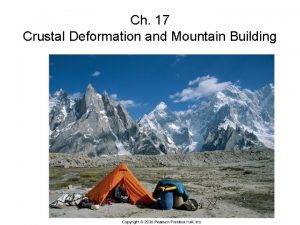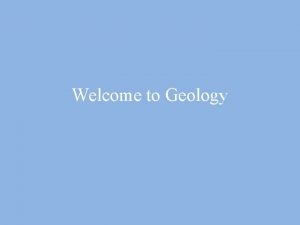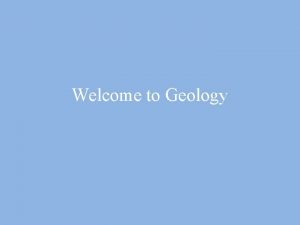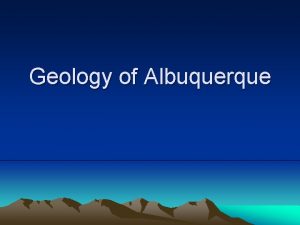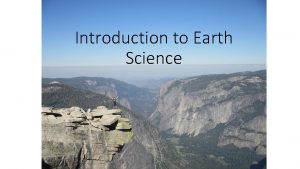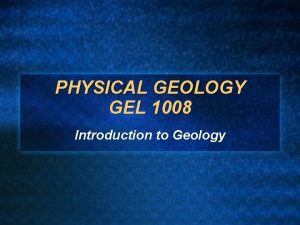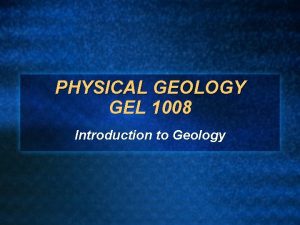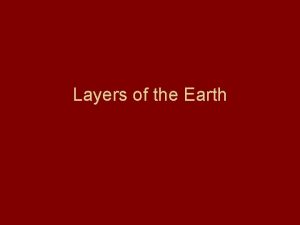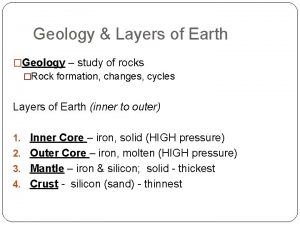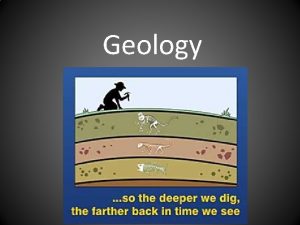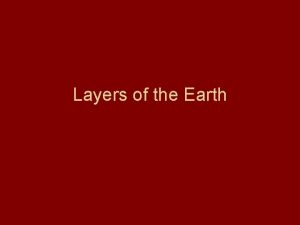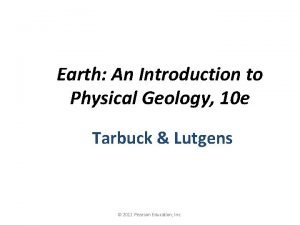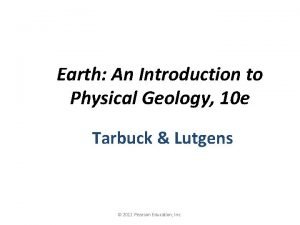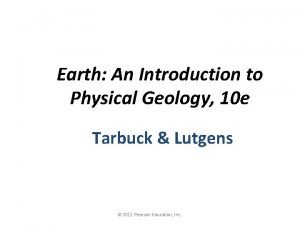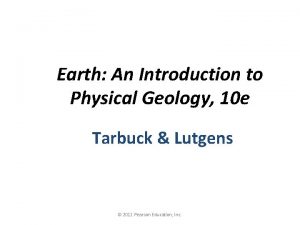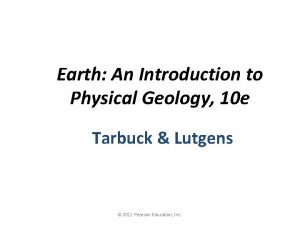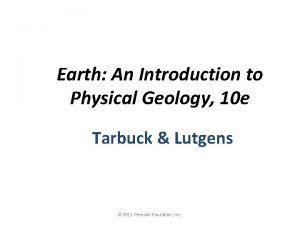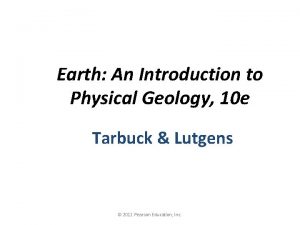Earth An Introduction to Physical Geology 10 e













































- Slides: 45

Earth: An Introduction to Physical Geology, 10 e Tarbuck & Lutgens © 2011 Pearson Education, Inc.

Crustal Deformation Earth, 10 e - Chapter 10 Stan Hatfield Southwestern Illinois College © 2011 Pearson Education, Inc.

Structural Geology • Structural geologists study the architecture and processes responsible for deformation of Earth’s crust. • A working knowledge of rock structures is essential to our modern way of life. © 2011 Pearson Education, Inc.

Deformation • Deformation is a general term that refers to all changes in the original form and/or size of a rock body. • Most crustal deformation occurs along plate margins. • Deformation involves: • Force—that which tends to put stationary objects in motion or changes the motions of moving objects © 2011 Pearson Education, Inc.

Deformation • Deformation involves: • Stress—force applied to a given area • Types of stress » Compressional stress shortens a rock body. » Tensional stress tends to elongate or pull apart a rock unit. » Shear stress produces a motion similar to slippage that occurs between individual playing cards when the top of the stack is moved relative to the bottom. © 2011 Pearson Education, Inc.

Deformation • Strain—changes in the shape or size of a rock body caused by stress • How rocks deform • Rocks subjected to stresses greater than their own strength begin to deform by folding, flowing, or fracturing. © 2011 Pearson Education, Inc.

Deformation • How rocks deform • General characteristics of rock deformation – Elastic deformation—The rock returns to nearly its original size and shape when the stress is removed. – Once the elastic limit (strength) of a rock is surpassed, it either flows (ductile deformation) or fractures (brittle deformation). © 2011 Pearson Education, Inc.

Deformation of Rocks © 2011 Pearson Education, Inc.

Deformation • How rocks deform • General characteristics of rock deformation – Factors that influence the strength of a rock and how it will deform » Temperature » Confining pressure » Rock type » Time © 2011 Pearson Education, Inc.

Folds • During crustal deformation, rocks are often bent into a series of wave-like undulations called folds. • Characteristics of folds • Most folds result from compressional stresses that shorten and thicken the crust. © 2011 Pearson Education, Inc.

Folds • Characteristics of folds • Parts of a fold – Limbs refers to the two sides of a fold. – An axis is a line drawn down the points of maximum curvature of each layer. – An axial plane is an imaginary surface that divides a fold symmetrically. © 2011 Pearson Education, Inc.

Folds • Common types of folds • Anticline—upfolded or arched rock layers • Syncline—downfolds or troughs of rock layers • Depending on their orientation, anticlines and synclines can be described as: – Symmetrical, asymmetrical, recumbent (an overturned fold), or plunging © 2011 Pearson Education, Inc.

Symmetrical Folds © 2011 Pearson Education, Inc.

Anticlines and Synclines © 2011 Pearson Education, Inc.

Syncline © 2011 Pearson Education, Inc.

Plunging Anticline—Wyoming © 2011 Pearson Education, Inc.

Folds • Common types of folds • Monoclines are large, step-like folds in otherwise horizontal sedimentary strata. • Other types of folds • Domes – Upwarped displacements of rocks – Circular or slightly elongated structures – Oldest rocks are in the center; younger rocks are on the flanks. © 2011 Pearson Education, Inc.

Monocline © 2011 Pearson Education, Inc.

Structural Dome © 2011 Pearson Education, Inc.

The Black Hills—A Large Dome © 2011 Pearson Education, Inc.

Folds • Other types of folds • Basins – Circular or slightly elongated structures – Downwarped displacements of rocks – Youngest rocks are found near the center; oldest rocks are on the flanks. © 2011 Pearson Education, Inc.

Structural Basin © 2011 Pearson Education, Inc.

The Michigan Basin © 2011 Pearson Education, Inc.

Faults • Faults are fractures in rocks, along which appreciable displacement has taken place. • Sudden movements along faults are the cause of most earthquakes. • Classified by their relative movement, which can be horizontal, vertical, or oblique. © 2011 Pearson Education, Inc.

Faults • Types of faults • Dip-slip faults – Movement is mainly parallel to the dip of the fault surface – May produce long, low cliffs called fault scarps – Parts of a dip-slip fault include the hanging wall (rock surface above the fault) and the footwall (rock surface below the fault). © 2011 Pearson Education, Inc.

Fault Scarp in California © 2011 Pearson Education, Inc.

Hanging Wall and Footwall Along a Fault Surface © 2011 Pearson Education, Inc.

Faults • Types of dip-slip faults – Normal faults » The hanging wall moves down relative to the footwall. » Accommodate lengthening or extension of the crust » Most are small with displacements of 1 meter or so. » Larger scale normal faults are associated with structures called fault-block mountains. © 2011 Pearson Education, Inc.

Normal Fault © 2011 Pearson Education, Inc.

Fault-Block Mountains © 2011 Pearson Education, Inc.

Faults • Types of dip-slip faults – Reverse and thrust faults » The hanging wall block moves up relative to the footwall block. » Reverse faults have dips greater than 45 degrees and thrust faults have dips less then 45 degrees. » Accommodate shortening of the crust » Strong compressional forces © 2011 Pearson Education, Inc.

Reverse Fault © 2011 Pearson Education, Inc.

Faults • Strike-slip faults • Dominant displacement is horizontal and parallel to the strike of the fault • Types of strike-slip faults – Right-lateral—As you face the fault, the opposite side of the fault moves to the right. – Left-lateral—As you face the fault, the opposite side of the fault moves to the left. © 2011 Pearson Education, Inc.

Aerial View of a Strike-Slip Fault in Nevada © 2011 Pearson Education, Inc.

Faults • Strike-slip faults • Transform faults – Large strike-slip faults that cut through the lithosphere – Accommodate motion between two large crustal plates © 2011 Pearson Education, Inc.

The San Andreas Fault System © 2011 Pearson Education, Inc.

Joints • Among the most common rock structures • Technically, a joint is a fracture with no movement. • Most occur in roughly parallel groups. • Significance of joints • Chemical weathering tends to be concentrated along joints. © 2011 Pearson Education, Inc.

Joints • Significance of joints • Many important mineral deposits are emplaced along joint systems. • Highly jointed rocks often represent a risk to construction projects. © 2011 Pearson Education, Inc.

Nearly Parallel Joints in Arches National Park, Utah © 2011 Pearson Education, Inc.

Mapping Geologic Structures • When conducting a study of a region, a geologist identifies and describes the dominant rock structures. • Usually, only a limited number of outcrops (sites where bedrock is exposed at the surface) are available. • Work is aided by advances in aerial photography, satellite imagery, and global positioning systems (GPSs). © 2011 Pearson Education, Inc.

Mapping Geologic Structures • Describing and mapping the orientation or attitude of a rock layer or fault surface involves determining the features. • Strike (trend) – The compass direction of the line produced by the intersection of an inclined rock layer or fault with a horizontal plane – Generally expressed as an angle relative to north © 2011 Pearson Education, Inc.

Mapping Geologic Structures • Dip (inclination) – The angle of inclination of the surface of a rock unit or fault measured from a horizontal plane – Includes both an of inclination and a direction toward which the rock is inclined. © 2011 Pearson Education, Inc.

Strike and Dip of a Rock Layer © 2011 Pearson Education, Inc.

A Geologic Map Showing the Strike and Dip of Structures © 2011 Pearson Education, Inc.

End of Chapter 10 © 2011 Pearson Education, Inc.
 Geology earth science definition
Geology earth science definition Astronomy definition earth science
Astronomy definition earth science Zone of aeration
Zone of aeration Earth science branches
Earth science branches Define physical geology
Define physical geology Introduction to geology ppt
Introduction to geology ppt Earth composition
Earth composition How many layers are there in the earth
How many layers are there in the earth What are earth's physical layers
What are earth's physical layers The 2 types of crust
The 2 types of crust Earth physical features
Earth physical features Earth's physical geography chapter 2
Earth's physical geography chapter 2 Study of the earth's physical features
Study of the earth's physical features Lesson 1: introduction to the earth
Lesson 1: introduction to the earth Chapter 1 introduction to earth science
Chapter 1 introduction to earth science Introduction to earth science
Introduction to earth science Geology is the study of
Geology is the study of Geology
Geology What is geology?
What is geology? Structural geology
Structural geology Stratigraphy
Stratigraphy Geology lecture series
Geology lecture series Grain size card
Grain size card Types of differential stress
Types of differential stress What is regolith in soil
What is regolith in soil Regolith geology
Regolith geology Arizona state university geology
Arizona state university geology How to write trend and plunge
How to write trend and plunge Geology of cuba:
Geology of cuba: Confined aquifer vs unconfined aquifer
Confined aquifer vs unconfined aquifer Maui elevation
Maui elevation Thrust geology
Thrust geology Outcrop patterns geology
Outcrop patterns geology Gcse geology data sheet
Gcse geology data sheet Gcse geology
Gcse geology Seismic beach balls
Seismic beach balls Osk
Osk Structural geology
Structural geology Mohr circle formula
Mohr circle formula Extinction in minerals
Extinction in minerals Department of geology university of dhaka
Department of geology university of dhaka Evento
Evento Chanel vidal
Chanel vidal Reverse fault
Reverse fault As level geology
As level geology Www.geology.sk
Www.geology.sk
